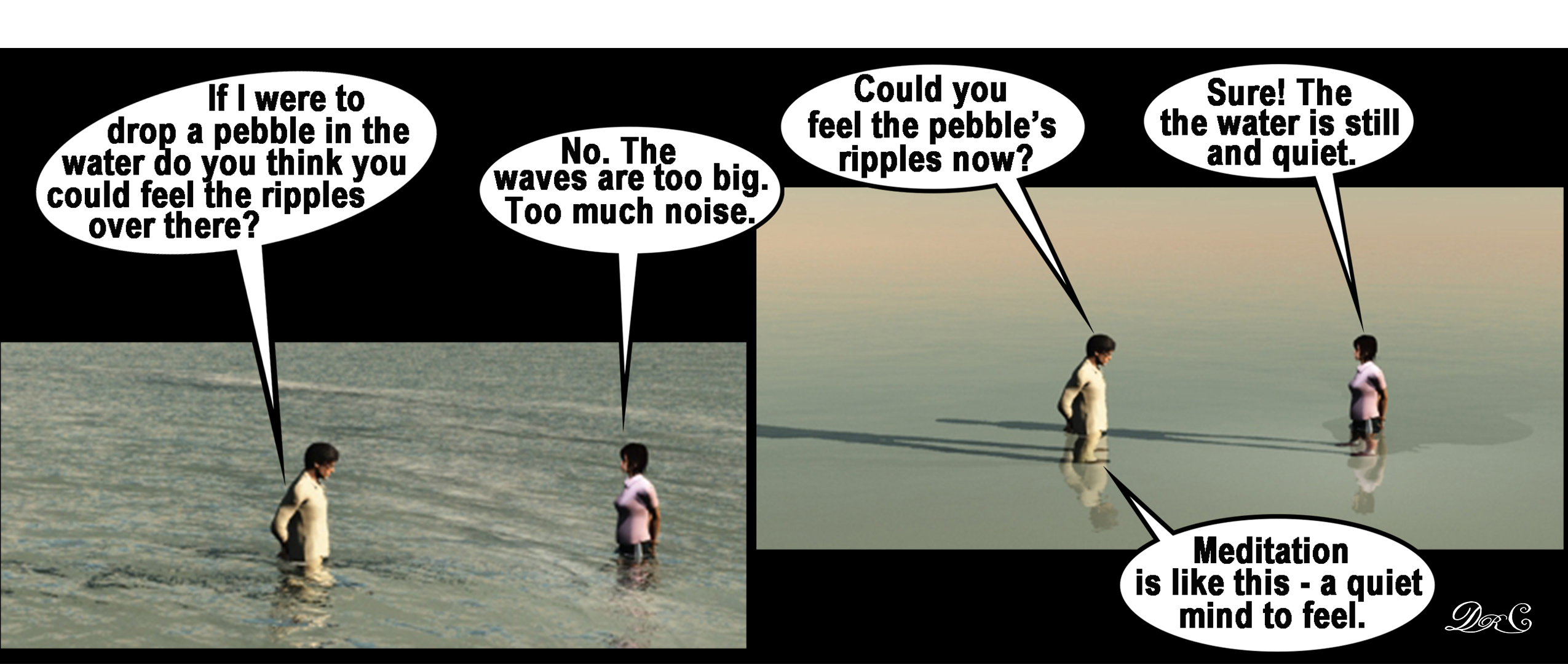Meditation and Parkinson’s Disease: Looking for Lightness of Being

(Graphic by Dr. C)
Living with Parkinson’s disease is a struggle against the loss of both motor and cognitive functions. One must invest effort into an action plan that reduces the impact of the disease — a rehab plan. This effort is daily (sometimes hourly) and can be exhausting.
Living with PD is like carrying a large backpack of rocks. It is at times a crushing burden that can overwhelm. Balance needs to be established in my life so that the work I do in fighting the disease does not consume me. I must spend time looking for lightness of being to balance out the heavy PD burden. I do this through a regular practice of meditation.
There are many ways to practice meditation: sitting and listening to calming music, sitting and gazing at a fireplace, practicing tai chi, or exercising with rhythmic breathing. These practices seek to help one enter the quiet mind. It is within the quiet mind that one experiences lightness of being. Meditation helps relieve stress and focus attention — both of which are of benefit to those with PD. There are books providing instructions on how to do this, but none deal directly with PD.
Join the Parkinson’s forums: an online community for people with Parkinson’s Disease and their caregivers.
Practicing meditation with PD presents some unique challenges. The meditation practice starts with calming the body, and this is the first obstacle PD complicates. Repetitive motor activities like cycling, tai chi, or gardening are helpful when combined with focused breathwork.
Focused breathwork is diaphragm breathing in which you focus your full attention on the breath. Guided meditation, either from a teacher, in person, or from a recording, can help with this process of shifting attention. This shifting of attention is the second obstacle PD complicates.
Once past the first two obstacles, you should feel a little more relaxed. This relaxed state is the path leading to the door into the quiet mind, but I am prevented from going down that path by a third obstacle.
This third obstacle is heightened emotions and difficulty in regulating them. I have written about how PD heightens the impulse signals to the brain. During the meditation process, the signal-to-noise ratio changes, meaning that as one practices quieting the mind, the noise goes down and the signals connected to emotion appear louder.
The quiet mind is a mental state that silences the noise of the world, the body, and the self while at the same time maintaining a sense of peace and safety. It is something I practiced for decades and then lost touch with over the last seven years while battling PD. As my life has become stable, I am now returning to the practice and finding it much more difficult. I feel like a novice struggling with all the obstacles I used to walk around with ease. This third obstacle does impede my looking for lightness of being.
As I have helped patients to find a place of peace and safety, together we would often experience loud emotions. These are emotions connected to things we feel (consciously or subconsciously) that need attention. They are like boulders in the path, looking like obstacles blocking the way forward to the quiet mind. But one can learn to walk around them.
Most of the folks I worked with would have several boulders to walk around and needed multiple sessions to learn how to walk around them. As I write this, I remember the tender patience I should offer to myself.
Once past the boulders of emotion, you then arrive at the doorstep of the quiet mind. PD has made looking for lightness of being much more difficult for me, but not impossible. I have memories, and recently have felt glimpses of peace and deep calmness.
Seeking lightness of being ties into my New Year’s resolution. For me to quiet down the old tapes (emotional boulders in the path), I need to have a new mental state to go to. I can’t just remove the tapes and leave a void, because that void will be quickly filled back in with the old mental habits. Looking for lightness of being will be a lifetime adventure.
What ways do you practice meditation, and how have you found it to be helpful?
***
Note: Parkinson’s News Today is strictly a news and information website about the disease. It does not provide medical advice, diagnosis or treatment. This content is not intended to be a substitute for professional medical advice, diagnosis, or treatment. Always seek the advice of your physician or another qualified health provider with any questions you may have regarding a medical condition. Never disregard professional medical advice or delay in seeking it because of something you have read on this website. The opinions expressed in this column are not those of Parkinson’s News Today or its parent company, BioNews Services, and are intended to spark discussion about issues pertaining to Parkinson’s disease.







Comments
Iulian Ghimici
This is just marvelous ! I wish you all the best and thank you for the wisdom that one can get from every single word of your share ! Namaste
Thirunavukkarasu
A very good example to understand. Meditation keeps the mind ripple-less. Yogas Chitta Vritti Nirodhah.
michael wall
I also found my meditation practice disrupted by the onset of Parkinson's. Here's a simplified version of Tich Naht Hanh's famous "smiling" meditation I found really helpful when I started again: "Breathing in, I calm my body - Breathing out, I smile - Breathing in, present moment - Breathing out, wonderful moment"